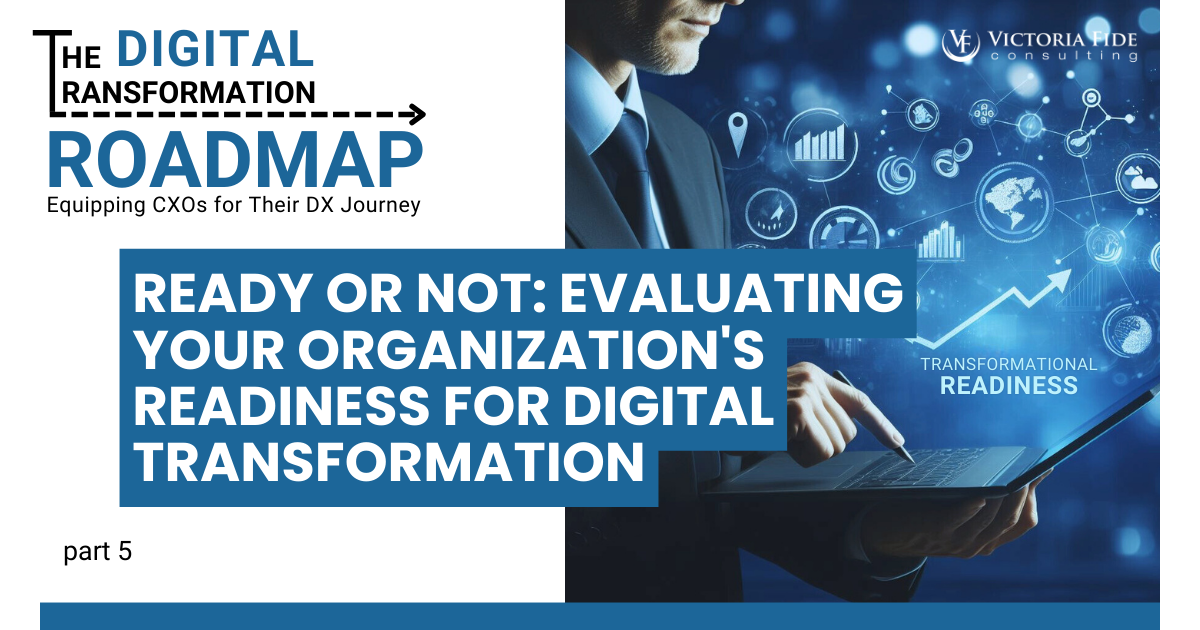
Ready or Not: Evaluating Your Organization’s Readiness for Digital Transformation
The DX Roadmap series is produced by Victoria Fide Marketing with input and oversight from our leadership team and industry SMEs.
Table of Contents
In last week’s article, we discussed the importance of performing an Enterprise Technology Review. to illuminate the strengths and weaknesses within your current technological systems and practices. This provides a clear view on what needs to be addressed before embarking on your transformational road trip, and is similar to taking your car to the local mechanic for a diagnostic check to make sure your vehicle is road-worthy.
Next, it’s time to take a look at any potential dangers along your route so you are equipped to navigate them. For example, if you were to travel abroad, you’d likely spend time researching the political climate of the foreign country, what regulatory requirements you’ll need such as a passport, visa, and fraud protection, and what sort of medical care is available to you if you happen to get injured. For underdeveloped countries, you may also need to look into the safety of water and food sources, and possibly hire a seasoned guide to help you navigate the foreign country. In essence, the precautions you take when getting ready for a trip to a high-risk destination differ from those for a low-risk one.
Similar to taking precautions on a trip to a foreign country, it’s important to recognize any potential risks before embarking on your Digital Transformation (DX) journey by conducting an Organizational Maturity Assessment and a Risk Assessment. We will cover the Risk Assessment in the next article. In this article we discuss Organizational Maturity.
While addressing all the aspects of a formalized Organizational Maturity Assessment would require more detail than a single article can provide, there are several organizations – including Victoria Fide – that can provide this assessment. This article will instead explore organizational maturity, its characteristics, and how to gauge your organization’s general maturity level. Additionally, we will also analyze how organizational maturity impacts digital transformation, empowering you to manage risks linked to significant changes. Ready to begin? Let’s get started.
What is Organizational Maturity?
Francesc Güell defines the maturity of an organization as, “a measure of [an organization’s] ability to adapt to the environment, to learn, to improve results.” Considering digital transformation is all about change, it stands to reason that organizations with low organizational maturity will struggle greatly with their transformational efforts.
There are five levels of organizational maturity that companies often progress through as they evolve and grow:
- Initial: At this level, organizations are in an experimental phase with unstable processes. It is chaotic with no clear structures, inconsistent actions, and unpredictable outcomes.
- Emergent: At this level, the organization transitions towards structure and control with managed processes, basic standards, and some predictability.
- Structured: The organization has clear guidelines, defined processes, and a measurement focus. The organization also operates with structure and showcases team competence.
- Integrated: At this level the organization aligns with its surroundings, has processes focused on strategic goals, high predictability, disciplined operations, and uses metrics and KPIs for decision-making.
- Optimized: Organizations at this level have reached the pinnacle of maturity. They thrive through adversity, adapt swiftly, seize opportunities, take a proactive approach to problem-solving, and foster continuous improvement, driving innovation and growth.
You may notice that organizational maturity levels are closely linked to operational maturity levels. Operational maturity is a general measure of the overall consistency, reliability, resilience, and coherence of an organization’s operations. The key distinction between organizational and operational maturity lies in their focus: Operational Maturity assesses the organization’s execution efficiency, while Organizational Maturity evaluates its effectiveness in enhancing execution. The two are interdependent, as operational maturity enhances organizational maturity and vice-versa.
Navigating Risk Factors in Digital Transformation: The Role of Organizational Maturity
One of the key risk factors in digital transformation projects arises from the organization’s level of maturity. According to a study by Process Excellence Network and Gartner, “change programs in high maturity organizations almost always succeed.” To ensure success in your digital transformation journey, it is crucial to address risks, with organizational maturity being a significant concern. Conducting an Organizational Maturity Assessment can help you gauge your organization’s maturity level accurately, which will directly impact your risk mitigation plans. We will cover risk mitigation in more detail in later articles.
The organizational maturity assessment provides valuable insights into areas that need improvement and attention. By prioritizing the enhancement of organizational maturity before initiating transformation efforts, you not only mitigate potential risks but also establish a more robust foundation for successful DX initiatives in the future. Ultimately, recognizing your organization’s capacity to adjust to change is crucial; otherwise, embarking on a major digital transformation will be fruitless.
Organizational Maturity Assessment: Key Questions for Growth
Conducting a comprehensive Organizational Maturity Assessment involves intricate details beyond the scope of this brief article. To ensure a thorough assessment, we recommend engaging an external consultant. This approach not only offers a new perspective but also optimizes your time, enabling you to prioritize other facets of your digital transformation journey.
Transformation is not easy, but it doesn’t have to be impossible. Take control of your project’s success today and schedule a free 30-minute consultation to find out how Victoria Fide can equip you for transformational success.

It is our experience, however, that most organizational leaders intuitively know their organization’s approximate level of maturity. To gain a general overview of your organization’s maturity level, consider the following self-assessment questions and rate yourself on a scale of 1-5:
Processes
- Are there clearly defined, documented, and repeatable processes within my organization?
- Are our processes standardized and do they follow best practices?
- Are our processes aligned with our strategic business goals?
- Are the processes being adhered to?
Predictability
- Are our outcomes, outputs, and quality predictable?
- How effectively do we define and measure KPIs?
- Are we consistently reaching our business success metrics?
- How accurately are we able to forecast?
Structure
- Are our resources being managed and maintained well?
- How easily can my employees find what they need?
- How quickly are new employees able to operate independently?
- Are we able to adopt new procedures with ease?
Governance
- What is the level of accountability throughout the organization?
- Is there a clear delineation of roles and responsibilities?
- How well does our team respond to change?
- How have any past change initiatives gone?
These questions are far from being comprehensive, but rather they are designed to be a starting point to get you thinking about your organization’s maturity and change readiness. By answering these questions honestly, you can begin to understand where your organization stands and identify areas for improvement. Remember, the higher your level of organizational maturity, the more likely you are to succeed in your digital transformation journey.

Next Steps: Proactively Improving Organizational Maturity
If change comes seldom and with great difficulty, you need to increase your organizational maturity before you can succeed with your transformational initiatives. If you’ve discovered that your organizational maturity is either at the Initial or Emergent level, you’ll need to seriously consider increasing your maturity level before undertaking a significant DX project. You can read this article for some strategies for increasing your organizational maturity.
If you fall somewhere between the Structured or Integrated levels, you are most likely in a good position to embark on your DX journey. However, the information you uncover during this assessment will inform the decisions and steps you take to mitigate the risks associated with significant change.
Finally, if you find that your organization is at the Optimized level of maturity, congratulations! You have reached the pinnacle of maturity and are well-positioned to continue to thrive in the shifting business landscape. Prioritize continuous learning and optimization, focusing on empowering your teams to take ownership and drive change to stay ahead of the competition.
If you want to know whether your organization is ready for a transformational technology initiative, reach out today to schedule an organizational maturity assessment. We will provide you with insights you need to be able to plan and prepare for your digital transformation journey and will give expert recommendations based on your strategic business goals.
This organizational maturity assessment, a pivotal step in our strategic planning, will directly influence the upcoming organizational risk assessment which we will cover next week. Are you ready to take control of your DX journey and lead your company to greater heights? Subscribe to receive proven, tactical steps for DX success and join us as we unravel the intricacies of digital transformation together.
Subscribe to our weekly LinkedIn Digital Transformation Success newsletter and get notified of each new edition.
